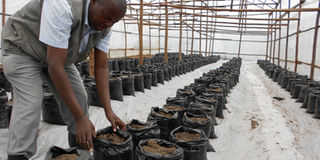Greenhouses give him better yields and more cash

William Kwezi arranges pots in a newly set up greenhouse. Photo by William Odinga Balikuddembe.
What you need to know:
Crops need a right combination of temperature, nutrient and soil to grow. Because nature is unpredictable, greenhouses offer the farmer the control of these elements. One farmer told William Odinga Balikuddembe how greenhouse farming increased his yields and income.
My name is William Kwezi. I am 45 years old. I live in Gayaza, Wakiso District. I have been doing a lot of farming for the last 15 years but four years ago, I decided to start using greenhouses. My farm is in Kayebe-Gayaza. I grow horticultural crops including tomatoes, sweet pepper and cucumber.
Open field vis-à-vis greenhouse farming
In open-field cultivation, weather imbalances have a huge impact on productivity. You cannot be sure of how much you will harvest. Sometimes, there is a lot of sunshine, and sometimes a lot of rain.
These changes can result in huge crop losses. But with greenhouses, everything is controlled. I control the temperatures, the water supply, and everything else. I know what to expect from my greenhouse.
Using local materials for greenhouses
I build the greenhouses myself using local materials. Where some people use metal for poles, I use eucalyptus. I have also been building greenhouses for other farmers.
The only materials I buy from the shop are the sheets, which come in a kit. The kit covers an area of 160 square metres; this is a greenhouse of 20 by 8 metres. This kit costs about Shs2.2m at Nsanja Agrochemicals Ltd.
I employ 10 people. These include plumbers, carpenters and casual labourers. It costs me about Shs 700,000 in labour to put up one greenhouse.
Profitability of greenhouses
The profitability of a greenhouse varies from crop to crop. Tomatoes, for example, take two and a half months to grow. You can harvest them for a period of four or six months, depending on the management of the greenhouse.
Each greenhouse, measuring 20 by eight metres, takes between 600 and 650 plants and each plant can yield between 10 and 15 kilogrammes in its lifetime. A kilo of tomatoes sells between Shs1,800 and Shs3,500. Currently, a kilo of tomatoes is at Shs3,000. At the minimum, you have Sh10.8m from one greenhouse after complete harvest of the tomatoes – and the greenhouse can last for three years.
With sweet pepper, it is the same number of plants per greenhouse. A plant can produce six to seven kilogrammes; A kilo is between Shs6,000 and Shs9,000. The lifespan of sweet pepper is six months.
From one greenhouse, in the first year, one could invest up to Shs7.5m and earn Shs11m. That is a profit margin of Shs3.5m. For the next two years, the profit margin is much higher (up to 80 per cent) because the infrastructure is already there.
Challenges in green house farming
The challenges we face with greenhouses include wind, which can blow them down, and capital. You need at least Shs6.5m to build a greenhouse and have it stocked with crops. And you still have to spend more money on fertilisers and pesticides.
We spray pesticides every week to kill pests while for weeds, we suppress their growth
When I was starting I sold my car and added on my savings to raise Shs6.2m to complete my first greenhouse.
The other thing is that if one does not have enough knowledge about greenhouse farming, they will find challenges. You have to manage it very well, control temperatures, irrigation and so on.
Options for those with little capital
Those with less money have the option of using net-sheds or open-drip irrigation to practice at least some organised farming. This will give them better yields than the usual practice of solely depending on rainfall. A net-shed, for example, shields crops from direct sunshine.
Mid-day sunshine can be so rough. It makes the crops lose a lot of water. The shed reduces the sunshine reaching the crop by 35 per cent. You can also employ drip-lane irrigation in a net shed. To set up a net-shed, you use 40 per cent less the cost of a greenhouse. This is affordable for many farmers.
Training of farmers
Two years ago, I stated a company called Nkuruba Integrated Development Agricultural Services (NIADS), which provides training to farmers who intend to practice organised farming.
I am establishing a demonstration farm in Kalanamu, Luweero District, near Bugema University. It will have greenhouses, net-sheds and open-drip irrigation. We will also practice aquaculture (fish farming) in greenhouses at this place.
Since I started this type of farming I have been building greenhouses for many people. I have been training them. The challenge is that you cannot train everyone from their farm. It becomes very taxing.
This is why I am establishing this demonstration farm where all people can come and learn. Five greenhouses are complete and running. We shall be opening this centre to the general public in about four months. There will be arrangements for them to come into the farm and train for a small fee.
Advice to farmers
Weather imbalances have caused a lot of problems to domestic and commercial farming. I think the way to go is organised and controlled farming.




